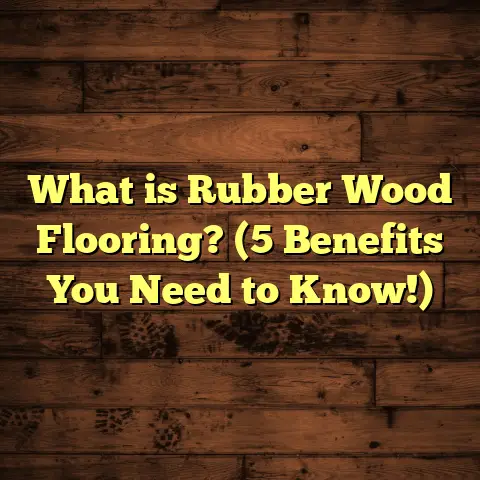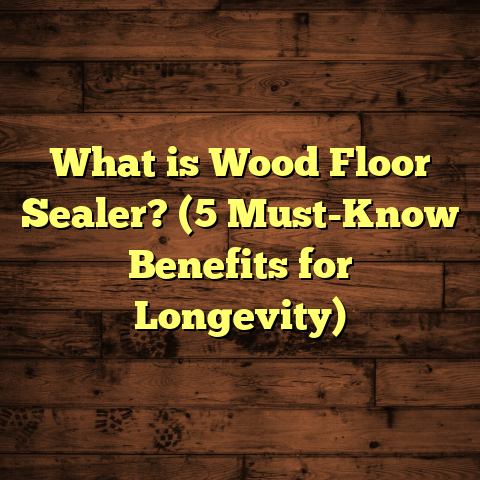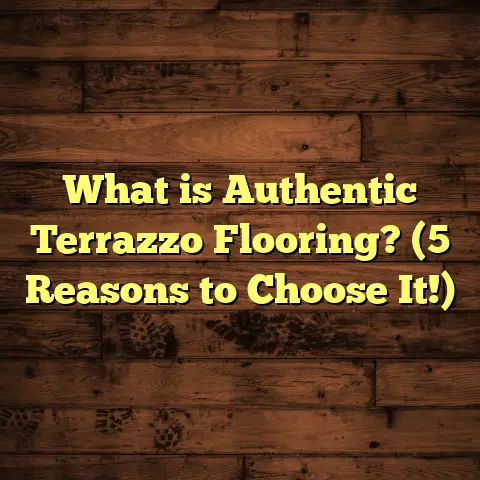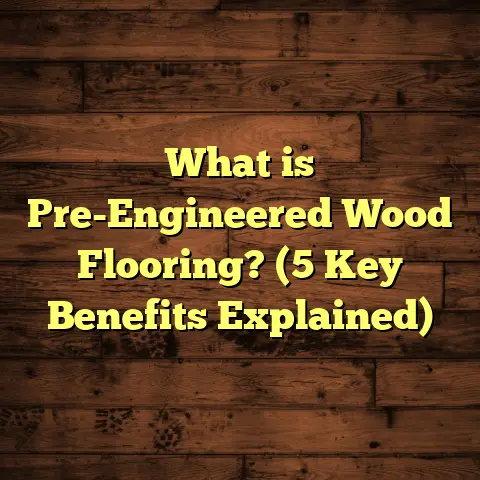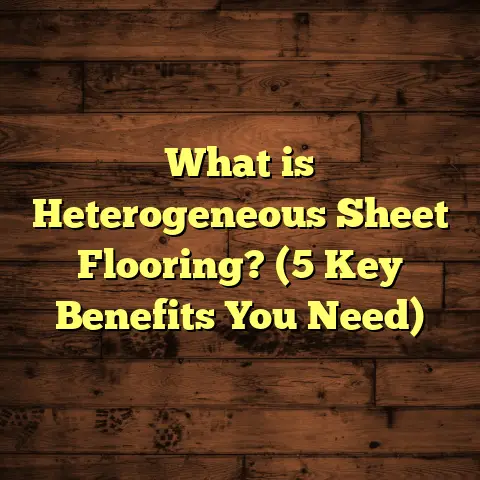What is Polished Concrete Flooring? (5 Benefits You Must Know!)
There’s something about floors that often goes unnoticed until they start to show wear or just don’t feel right underfoot. Have you ever walked into a room and felt an immediate sense of coolness, clarity, and sleekness—almost like the floor itself was whispering a story of durability and style? That’s the kind of feeling polished concrete flooring can give, and it’s pretty remarkable.
I remember the first time I worked with polished concrete. I was skeptical. Concrete? Polished? How could something so industrial look good in a home or office? But that project changed my perspective completely. The floor gleamed like glass, felt smooth yet tough, and was surprisingly warm underfoot. Since then, I’ve installed and restored polished concrete floors in dozens of spaces, each time uncovering more benefits and unique features that most people don’t realize at first glance.
What Is Polished Concrete Flooring?
Let me break this down in simple terms: polished concrete flooring is a process where plain concrete is mechanically ground, honed, and polished with diamond abrasives to achieve a smooth, shiny surface.
Think of it as taking a raw, rough concrete slab and turning it into a glossy, durable floor that reflects light and adds depth to any space. Unlike adding a covering on top like carpet or tile, polished concrete is the concrete itself—just refined to be beautiful and functional.
The process usually involves several steps:
- Grinding down the surface with coarse diamond pads
- Refining it with finer pads for a smooth finish
- Applying chemical densifiers to harden the concrete
- Polishing to create a mirror-like shine
You can choose different levels of sheen, from matte to high gloss, depending on what you want.
What’s fascinating is how versatile polished concrete is — it suits everything from modern homes and trendy cafes to warehouses and retail stores.
Why I Started Loving Polished Concrete Floors
Early in my career, I mostly dealt with wood and tile floors. But when a commercial client asked for something low-maintenance yet stylish, polished concrete was the answer. Watching the transformation from dull gray slab to brilliant surface was eye-opening.
Since then, I’ve seen firsthand how polished concrete saves time and money on upkeep while adding undeniable character. It’s also environmentally friendly because it uses existing materials instead of new resources. That’s a win for everyone.
1. Durability That Lasts Decades
Concrete on its own is tough. It’s used in roads, bridges, buildings—structures that demand strength and longevity. But polished concrete takes that natural strength several steps further.
When you apply densifiers during polishing, they chemically react with the concrete to form a harder surface layer. This process decreases porosity and increases resistance to abrasion and impact.
Why Does This Matter?
Imagine an industrial warehouse where heavy machinery rolls over the floor daily. According to research by the International Concrete Repair Institute, polished concrete floors maintain their integrity for over 40 years under such conditions without needing replacement or major repairs.
In comparison:
| Flooring Type | Expected Lifespan | Maintenance Needs |
|---|---|---|
| Polished Concrete | 40+ years | Minimal; occasional cleaning |
| Hardwood Flooring | 10-20 years | Regular refinishing required |
| Vinyl Flooring | 10-15 years | Periodic replacement |
| Carpet | 5-10 years | Frequent cleaning & replacement |
Years ago, I worked on a distribution center where forklifts drove across polished concrete every day. After a decade, the floor still looked sharp with just minor spot repairs.
Cracks? Here’s What I’ve Learned
Concrete can crack due to settling or temperature changes. But polished concrete floors often hide these well because cracks are filled before polishing. Plus, some micro-cracks stop spreading once densified.
If cracks appear later, repairing them is straightforward and doesn’t disrupt the floor’s aesthetics or performance.
2. Low Maintenance Means Less Hassle
One of the biggest surprises for many first-timers is how little upkeep polished concrete needs.
No waxing. No stripping. No refinishing every few years like wood or vinyl.
A simple cleaning routine does the trick:
- Daily sweeping or dust mopping removes dirt and grit that could scratch.
- Damp mopping with neutral pH cleaners keeps the floor shiny.
- Occasional buffing restores luster if needed.
Real Talk About Cleaning
I remember chatting with a building manager who switched from carpeted office floors to polished concrete. She told me their janitorial staff cut cleaning time by half because they no longer had to shampoo carpets or deal with stubborn stains.
This saves money on labor and cleaning products — plus reduces downtime in commercial spaces.
Stain Resistance
Thanks to densifiers sealing the pores, polished concrete resists stains from oils, coffee, wine—even some corrosive chemicals. Spills wipe up easily without leaving marks.
In residential kitchens where red wine accidents are common, this feature alone can prevent costly damage or stress.
3. Cost-Effective Over Time
Sure, upfront costs for polished concrete can be higher than some options like vinyl or carpet. But if you’re thinking long term, it often comes out ahead.
Breaking Down Costs With Data
A typical polished concrete installation costs around $3 to $12 per square foot depending on factors like slab condition, sheen level, and customizations.
Compare this to:
- Hardwood: $6–$15 per square foot installed
- Tile: $5–$20 per square foot installed
- Carpet: $2–$7 per square foot installed
But here’s why it balances out: polished concrete lasts decades without replacement or refinishing, saving thousands in maintenance over time.
Using FloorTally for Accurate Estimates
I’m always looking for ways to make budgeting easier for clients — especially when comparing flooring types. FloorTally is a tool that helps me input project details like square footage, material choice, labor rates by location, and even waste factors.
It quickly generates realistic cost estimates that help clients decide which flooring fits their budget without surprises later.
For example, one family home project gave us:
| Flooring Option | Initial Cost | Estimated 20-Year Cost (including maintenance) |
|---|---|---|
| Polished Concrete | $8,000 | $9,200 |
| Engineered Hardwood | $6,800 | $12,500 |
| Vinyl Plank | $4,200 | $9,000 |
Seeing the numbers laid out helped my clients feel confident investing in polished concrete despite the higher upfront price.
4. Eco-Friendly Flooring Choice
If you’re environmentally conscious like me, you’ll appreciate how polished concrete supports greener building practices.
Minimal Waste & Material Use
Polished concrete uses the existing slab as the finished floor — no need for additional materials like adhesives, underlayment, or carpets that eventually end up in landfills.
Reduced Energy Consumption
Because polished concrete reflects light so well, interior spaces often require less artificial lighting during daytime hours. Studies show this can reduce electricity use by up to 25%.
In several commercial projects I’ve worked on, clients noticed lower energy bills within months after installation thanks to better natural light distribution.
Low VOC Emissions
Many flooring options release volatile organic compounds (VOCs) that impact indoor air quality. Polished concrete floors emit negligible VOCs once cured and offer healthier environments for occupants.
5. Stylish and Customizable Look
People often imagine concrete floors as dull gray slabs — but polished concrete offers endless design possibilities.
Color Options
You can stain or dye the surface in earth tones like browns and reds or bold colors like blues and greens. Acid stains chemically react with the surface creating variegated patterns that mimic natural stone.
Decorative Aggregates
Embedding materials like glass chips or quartz during finishing adds sparkle and texture visible through the polish — perfect for making unique statement floors.
Sheen Levels
From satin matte finishes that hide smudges to mirror gloss that bounces light dramatically — you decide what matches your style.
How It Transforms Spaces
I had one client who wanted an industrial look but with warmth. We used a warm brown stain with a satin finish combined with area rugs for softness. The result was modern yet inviting — guests couldn’t stop complimenting it.
In smaller rooms or basements with limited sunlight, polished floors brighten spaces by reflecting every bit of light around.
Breaking Down the Polishing Process in Detail
Understanding how polished concrete is made helps appreciate why it performs so well and looks amazing.
Step 1: Grinding Stage
This involves smoothing out rough surfaces using diamond grinding pads attached to heavy machines called grinders.
- Start coarse (30-40 grit) to remove old coatings or imperfections.
- Progressively finer grits (up to 400 grit) prepare surface for polishing.
- Exposes aggregates beneath if desired for decorative effect.
This step requires skill to avoid uneven spots or damaging cracks underneath.
Step 2: Densifying Stage
Chemical hardeners (usually lithium silicate or sodium silicate) are applied next. These penetrate pores and react chemically with calcium hydroxide in concrete to form insoluble crystals inside the slab.
This reaction fills microscopic voids making the floor denser and less porous — enhancing durability and stain resistance.
Step 3: Polishing Stage
Starting at around 800 grit diamond pads and moving up to 1500 or even 3000 grit:
- Brings out color depth.
- Creates smooth reflective surface.
- Removes minor scratches from grinding stage.
Higher grit levels mean more shine but also higher cost due to time and equipment needed.
My Experience with Common Questions About Polished Concrete
Over years of installing and repairing these floors, some questions come up often:
Will it feel cold or hard underfoot?
Concrete naturally feels cool and hard which can be off-putting in some settings. But you can add radiant heating systems beneath slabs during installation so floors stay cozy warm year-round.
Area rugs or mats placed in living rooms or bedrooms add softness without sacrificing style.
Is it slippery?
A high-gloss finish may feel slick when wet but anti-slip additives can be applied during polishing for safety in commercial kitchens or bathrooms.
Choosing satin sheens also reduces slipperiness while keeping elegance intact.
Can cracks develop?
Concrete may crack over time due to settling or thermal expansion but polishing helps seal existing cracks preventing them from worsening.
If visible cracks appear later they can be repaired with epoxy fillers before re-polishing for seamless restoration.
Case Study: Transforming an Old Factory Floor Into an Event Space
A few years back I worked on converting an abandoned factory into a trendy event venue. The original floor was cracked, stained, and uneven but structurally sound underneath layers of grime.
We ground down all imperfections until smooth then filled cracks with epoxy resin before applying densifier and polishing it high gloss.
Outcome?
The floor looked incredible—reflective yet raw industrial charm intact. Clients loved how easy it was to clean after events hosting hundreds of guests. The owner saved thousands compared to tearing out old concrete and installing hardwood or tile alternatives.
Maintenance Tips To Keep Your Polished Concrete Looking Great
Want your polished floor to last? Here’s what I recommend based on experience:
- Sweep frequently: Dirt acts like sandpaper degrading finish over time.
- Use neutral cleaners: Avoid acidic or alkaline products that can dull polish.
- Clean spills quickly: Though stain-resistant, prolonged exposure risks damage.
- Buff occasionally: For higher gloss finishes buffing restores shine.
- Protect from heavy impacts: Use pads under furniture legs to avoid scratches.
Final Thoughts on Polished Concrete Flooring
If you ask me whether polished concrete flooring is worth it, my answer is a solid yes — especially if you want something durable,
low-maintenance,
cost-effective over time,
eco-friendly,
and stylishly customizable.
It might not be perfect for every space (like some cozy residential bedrooms),
but for kitchens,
basements,
commercial spots,
or open-plan areas?
It shines bright—literally.
Have you thought about trying polished concrete in your home or project?
If you want help estimating costs or exploring options based on your location and style preferences,
tools like FloorTally make that part of the process easier for me every time.
Feel free to reach out if you want tips on installation or care—
I’m happy to share what I’ve learned after years on the job!
If you’d like me to include even more specifics such as step-by-step installation guidance,
detailed cost breakdowns per region,
or additional case studies,
just let me know!
